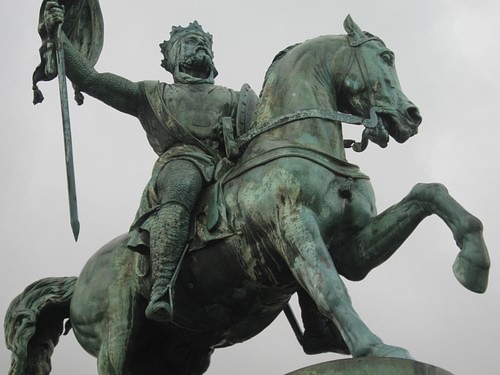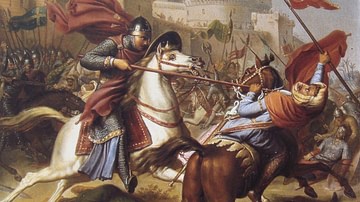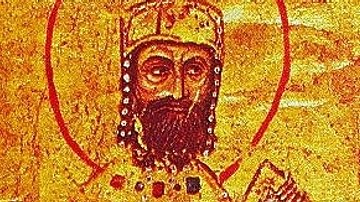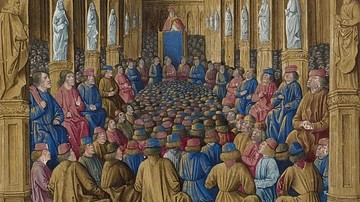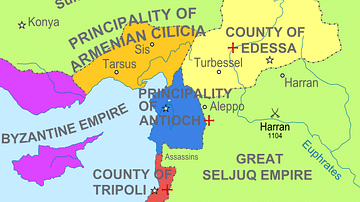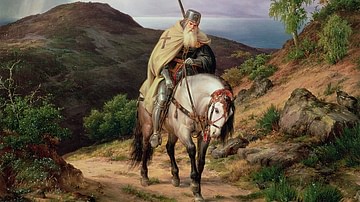The capture of Jerusalem from Muslim control was the primary goal of the First Crusade (1095-1102 CE), a combined military campaign organised by western rulers, the Pope, and the Byzantine Empire. After a brief siege, the city was captured on 15 July 1099 CE and the population massacred. A Muslim relief army was defeated three weeks later, and the First Crusade was hailed as a remarkable success in the west. The huge problems of logistics, famine, disease, a formidable enemy, and internal rivalries had all, somehow, been overcome, but the future defence of the Holy Land would require many more crusades over the next two centuries, and none would be as successful as the first.
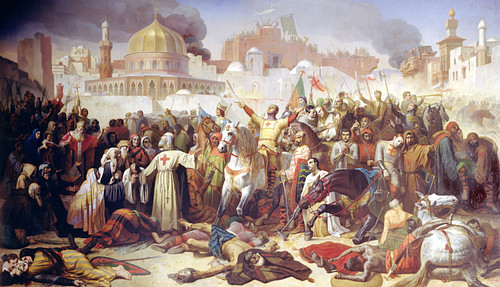
Prologue
The First Crusade was conceived by Pope Urban II (r. 1088-1099 CE) following an appeal from the Byzantine emperor Alexios I Komnenos (r. 1081-1118 CE) who wanted to fight back against the expanding Muslim Seljuk Turks who had robbed Byzantium of a good portion of Asia Minor. The fact that Jerusalem, the holiest city in Christendom, had also fallen, proved a great motivator for knights to travel from all over Europe and try to retake it. The mixed force of Crusaders and Byzantines enjoyed success, notably recapturing Nicaea in June 1097 CE, winning a great victory at Dorylaion on 1 July 1097 CE, and capturing Antioch on 3 June 1098 CE after a protracted siege.
The next and main target was Jerusalem, although since the Crusade had been called, the Fatimid Shiite Muslims of Egypt had taken control of the city from their Sunni Seljuk rivals. Jerusalem - of course, a holy city for both the Christian attackers and the Muslim defenders - was purely a symbolic target of the Crusade as the historian T. Asbridge here summarises:
Despite its spiritual significance, Jerusalem's isolated position in the Judean hills meant that its political, economic and strategic value was limited. (540)
In December 1098 CE the crusader army marched to Jerusalem, capturing several Syrian port cities on their way and Bethlehem to boot. They arrived, finally, at their ultimate destination on Tuesday, 7 June 1099 CE. Of the vast army that had left Europe there were now only around 1,300 knights and some 12,500 infantry, not a large force considering the mighty fortifications of the Holy City which dated back to the time of the Roman Emperor Hadrian (r. 117-138 CE). The Byzantines and Muslims had repaired and extended the city's double walls over the years and sections of these were over 18 metres (60 ft) high and 3 metres (10 ft) thick. The city was naturally protected on three sides by deep ravines, moats and precipices. Even inside the city, there were two massive fortified towers: the Tower of David and the Quadrangular Tower. A siege was the strategy most likely to achieve a positive result with the minimum loss of life but the one thing the Crusaders did not have was time: an enemy relief army would surely already be on its way, just as had happened at Antioch the year before.
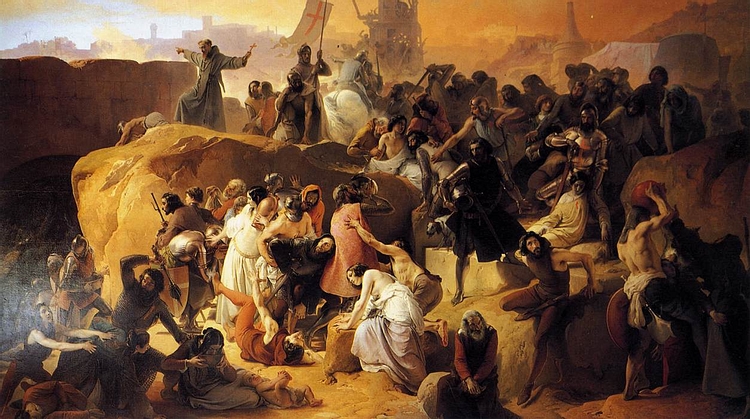
The Siege
The man in charge of the defence was Iftikhar ad-Dawla, and he commanded a large garrison of mostly Arab and Sudanese soldiers - perhaps several thousand infantry and an elite cavalry corps of 400 Egyptians. The force was not sufficient to man all sections of the walls, which had just been repaired, although Iftikhar ad-Dawla did have some stone-throwing catapults at his disposal. Jerusalem had no water source within its walls but it did have large cisterns so that, with appropriate supplies, the defenders could hope to last out a siege for some time until the promised relief force came from Egypt. The Fatimid governor removed any livestock from the surrounding area and poisoned all the wells outside the city so that the attackers gained no advantage from them. As a sensible precaution against treachery, all Christians were kicked out if the city. In contrast, the Jewish population were allowed to stay.
Three of the main leaders of the Crusader army, Robert of Flanders, Godfrey of Bouillon, and Robert of Normandy, established their separate camps close to the northern and north-west walls, covering the gates in that stretch. Meanwhile, Raymond of Toulouse occupied Mount Sion, and the Norman Tancred herded livestock from Bethlehem before taking up position at the north-west corner of the city.
A bombardment using mangonel catapults began at once, but the attackers were soon having problems with their food and water supply thanks to Iftikhar ad-Dawla's forethought and a particularly hot spell of weather. Desertions were not uncommon, and raiding parties from the city persistently targeted the enemy troops charged with acquiring fresh water and food for the Crusader camps. It seemed that the attackers would soon be suffering more privations than the defenders, and so a direct assault was agreed upon. On 13 June the Crusaders attacked the north walls, but their lack of equipment to scale them proved their downfall, and they were forced to withdraw.
Fortunately for the Crusaders, a solution to the problem was just on the horizon. On 17 June a number of Genoese and English ships arrived at the closest port, Jaffa, with weapons, food, and more importantly, rope and timber, which were used to make two huge siege towers, catapults, scaling ladders, and a battering ram. Time was now of the essence, though, as definite news came in the first days of July that a massive Egyptian army was on its way to relieve the city. The Fatimid governor would have got wind of their imminent arrival too, and this perhaps explains why he was remarkably reluctant to attack in force the Crusader's camps.
On 8 July, the Crusaders prepared for their all-out assault. Led by priests bearing holy relics, they walked around the city barefoot in a procession of penance, which served as a reminder to all of why they had come to this place. Even the bickering northern leaders were moved to reconcile their differences. After three years of hardship, exhausting battles at Antioch and other places, morale was high as the Crusade was, finally, about to be concluded.
On 10 July, the two siege towers were ready for action, and they were wheeled against the walls on Mount Sion and the north wall. A third much smaller tower was set up against the north-west corner of the fortifications. Naturally, the defenders did not stand idle and bombarded the towers with rocks and Greek Fire, the highly flammable liquid that, ironically, the Christian Byzantines had invented. The Crusaders launched a full attack on the night of the 13th. A day of fierce fighting followed, and on the night of the 14th the tower at the north wall was dismantled and relocated. Surprising the defenders at daybreak when they realised the new attack-point, the tower got close enough for a few men, led by Godfrey of Bouillon, to scale the walls and hold a section of it while more men climbed scaling ladders. On the morning of the 15th of July 1099 CE, one of the main gates was opened, and the Crusaders were inside the city.
Final Victory & Slaughter
A group of remaining defenders fled in panic to the Dome of the Rock, but with no possibility of effective defence, they surrendered to Tancred who promptly hoisted his purple banner over the Mosque of al-Aqsa (just as he had done a few months earlier at Bethlehem). Meanwhile, a second group, still commanded by Iftikhar ad-Dawla, rallied in the Tower of David in the southern quarter of the city where they were met by Raymond. The governor offered a huge ransom to spare his life and his bodyguard. Raymond accepted, but they were the only Muslims in the city who would live to see another day.
There followed a mass slaughter of all the Muslims and Jews of Jerusalem, the latter being seen as accomplices. Figures of 10,000 (William of Tyre), 65,000 (Mathew of Edessa) or 75,000 (Ibn al-Athir) killed are all very likely an exaggeration as a contemporary Muslim source (Ibn al-Arabi), which had no motive for minimising the carnage, puts the figure at 3,000 of the city's probable 30,000 residents. Still, the barbarism of the Crusaders shocked even Christians, and the episode would never be entirely forgotten or forgiven by the Muslim states.
William of Tyre's description of the carnage, written in the 12th century CE, became one of the standard reports of the slaughter (despite the chronicler being born 30 years after the event):
It was impossible to look on the vast numbers of the slain without horror; everywhere lay fragments of human bodies, and the very ground was covered with the blood of the slain. Still more dreadful was it to gaze upon the victors themselves, dripping with blood from head to foot. (Phillips, 33)
The city was systematically ransacked and looted for its precious objects, and when the dead piled up to such an extent that they threatened to spread disease, Muslim prisoners were forced to burn the bodies of their fellows outside the city in huge pyres before themselves being massacred in cold blood. Meanwhile, back in Italy, Pope Urban II had died on 29 July 1099 CE without knowing the success or brutality of the crusade he had started.
Capturing Jerusalem was a remarkable achievement, but holding onto it was going to take more fighting. Within a month, a large Egyptian army of around 20,000 men arrived to take back the city. Commanded by the Fatimid vizier al-Afdal, the large force had sent scouts ahead, but these were captured by the Crusaders who, upon discovering the location of the enemy decided for an immediate surprise attack. Captured Egyptian spies were induced to reveal details of the enemy camp. By the 10th of August, the entire Crusader army had gathered at Ibelin, just a few kilometres from the enemy, camped just north of Ascalon. The Muslims were caught entirely by surprise and panicked, many of them retreating to a sycamore grove, where they perished after it was set alight. Others were driven into the sea, and the vizier's standard was captured. It was all over by the end of the day. Jerusalem was secure and Godfrey of Bouillon, the hero of the siege, was made its king.
Aftermath
For some historians, the battle at Ascalon marks the end of the First Crusade. Many of the crusaders returned home, including the leaders Raymond of Toulouse, Robert of Normandy, and Robert of Flanders. A fresh wave of crusaders would arrive from Constantinople, and there were more victories, notably at Caesarea on 17 May 1101 CE and Acre shortly after on 26 May. The Fatimids and Seljuks, though, were becoming more familiar with northern European tactics in warfare and began to rally. Holding onto their territorial gains in what became known as the Latin East would prove to be no easy task for the Crusaders; Edessa would fall, necessitating a Second Crusade (1147-1149 CE), and even Jerusalem was lost again in 1187 CE, which brought about the Third Crusade (1189-1192 CE).
